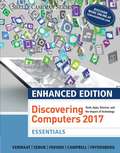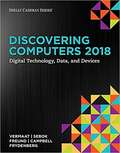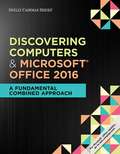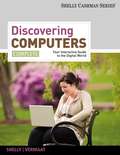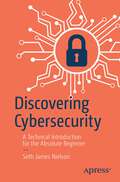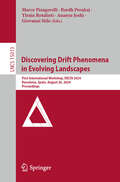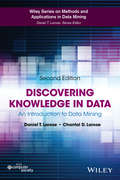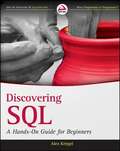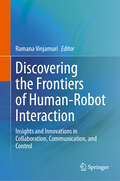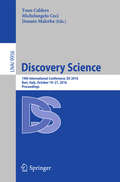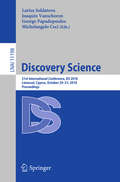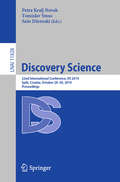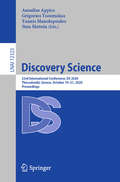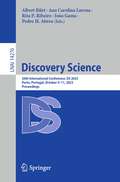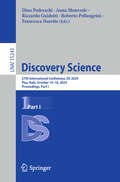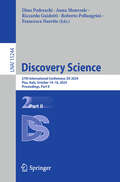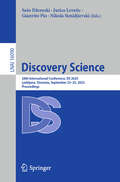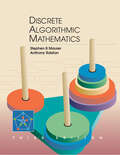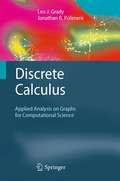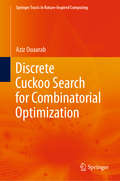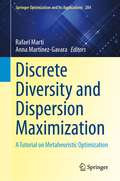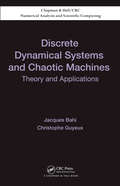- Table View
- List View
Discovering Computers 2017 Essentials: Tools, Apps, Devices, and the Impact of Technology, Enhanced Edition
by Steven M. Freund Misty E. Vermaat Susan L. SebokNIMAC-sourced textbook
Discovering Computers 2018: Digital Technology, Data, And Devices
by Steven M. Freund Misty E. Vermaat Jennifer T. Campbell Susan L. Sebok Mark FrydenbergLearn to maximize the use of mobile devices, make the most of online tools for collaboration and communication, and fully utilize the web and cloud with the latest edition of DISCOVERING COMPUTERS 2018. Clearly see how technology skills can assist you both in gaining employment and advancing your career. This edition highlights web development, how to create a strong web presence, and take full advantage of the latest Windows 10. To keep your instruction as current as possible, online coverage of contemporary technology developments builds on the book�s timely discussions. The authors provide helpful suggestions within a proven learning structure and emphasize meaningful practice to reinforce your skills. Self-assessments open each module and enable you to focus your study and learn more in less time. DISCOVERING COMPUTERS presents the key content you need to succeed, using an approach that ensures understanding.
Discovering Computers And Microsoft® Office 2016: A Fundamental Combined Approach
by Steven M. Freund Jennifer T. Campbell Susan L. Sebok Mary Z. Last Philip J. Pratt Misty E Vermaat Mark FrydenbergDISCOVERING COMPUTERS & MICROSOFT OFFICE 365 & OFFICE 2016: A FUNDAMENTAL COMBINED APPROACH combines strong computer concepts from the best-selling DISCOVERING COMPUTERS with proven step-by-step instruction on Microsoft Office365 and Office 2016 in one convenient book. This single resource delivers the best of Shelly Cashman Series -- the acclaimed Series that has effectively introduced computer skills to millions of learners. <P><P>This book encourages critical thought, personalization, and experimentation with the latest Microsoft Office 2016 software. Updated and revised computer concepts content throughout this edition reflect the evolving needs of those learning computing today with an exclusive focus on the skills needed to be successful in college and careers beyond. Enhancements ensure this edition delivers today’s most effective introduction to Microsoft Office 365 and Office 2016.
Discovering Computers: Your Interactive Guide to the Digital World, Complete
by Gary B. Shelly Steven M. Freund Misty E. Vermaat Jeffrey J. Quasney Susan L. SebokStudents are guided through the latest trends in computer concepts and technology in an exciting and easy-to-follow format. Updated for currency, DISCOVERING COMPUTERS: COMPLETE provides the most up-to-date information on the latest technology in today's digital world.
Discovering Cybersecurity: A Technical Introduction for the Absolute Beginner
by Seth James NielsonThe contemporary IT landscape is littered with various technologies that vendors claim will “solve” an organization’s cybersecurity challenges. These technologies are powerful and, in the right context, can be very effective. But misunderstood and misused, they either do not provide effective protection or do not protect the right things. This results in unnecessary expenditures, false beliefs of security, and interference with an organization’s mission.This book introduces major technologies that are employed in today’s cybersecurity landscape and the fundamental principles and philosophies behind them. By grasping these core concepts, professionals in every organization are better equipped to know what kind of technology they need, ask the right questions of vendors, and better interface with their CISO and security organization. The book is largely directed at beginners, including non-technical professionals such as policy makers, compliance teams, and business executives. What You Will Learn Authentication technologies, including secure password storage and how hackers “crack” password listsAccess control technology, such as BLP, BIBA, and more recent models such as RBAC and ABACCore cryptography technology, including AES encryption and public key signaturesClassical host security technologies that protect against malware (viruses, trojans, ransomware)Classical network security technologies, such as border security (gateways, firewalls, proxies), network IDS and IPS, and modern deception systemsWeb security technologies, including cookies, state, and session defenses, and threats that try to subvert themEmail and social media security threats such as spam, phishing, social media, and other email threats Who This Book Is ForProfessionals with no technical training in engineering, computers, or other technology; those who want to know things at a technical level but have no previous background; professionals with a background in policy, compliance, and management; technical professionals without a background in computer security who seek an introduction to security topics; those with a security background who are not familiar with this breadth of technology.
Discovering Drift Phenomena in Evolving Landscapes: First International Workshop, DELTA 2024, Barcelona, Spain, August 26, 2024, Proceedings (Lecture Notes in Computer Science #15013)
by Giovanni Stilo Marco Piangerelli Bardh Prenkaj Ylenia Rotalinti Ananya JoshiThis book constitutes the post-conference proceedings of the First International Workshop on Discovering Drift Phenomena in Evolving Landscapes, DELTA 2024, held in Barcelona, Spain, on August 26, 2024. The 9 full papers presented together with 1 short paper were carefully reviewed and selected from 17 submissions. The papers are grouped into three topical sections, namely: adaptive and robust learning in dynamic environments; challenges and solutions in drift detection and anomaly explanation; and innovative approaches to concept drift detection and landscape shifts.
Discovering Hidden Gems in Foreign Languages (Terrorism, Security, and Computation)
by M.D. MillerThis book offers a practical approach to conducting research in foreign languages on topics with a global nexus. It introduces the problem researchers face when getting started with a research problem, such as setting up the research environment and establishing goals for the research. The researcher then needs to prepares and to conduct foreign-language research by generating key terms and searching the right places where the information they seek is most likely to be stored. Using the appropriate advanced search operators, the researcher narrows down the search results to the desired sources, thereby eliminating the irrelevant sources. Specialized knowledge of country-specific domains advances the specificity and relevance of the researcher’s efforts. The methods and tools demonstrated in this book are applicable to a variety of academic and practical fields. A doctor may ask “what are other experts in my field saying about ABC disease?” A sommelier may ask “where else in the world are XYZ grape varietals grown?” A businessman may ask “who are my global competitors in my market?” A doctoral student may ask “have any other students at universities abroad ever written a dissertation about my topic, too?” With the tools and techniques demonstrated in this book, all of these questions are answerable. This book concludes with chapters on translation and citation methods, and includes three case studies that demonstrate the practical use of the methods discussed above. This book targets academic researchers as well as students and faculty. This book will also be a good fit as an assigned reading for a college course on thesis/dissertation research.
Discovering Knowledge in Data
by Daniel T. LaroseThe second edition of a highly praised, successful reference on data mining, with thorough coverage of big data applications, predictive analytics, and statistical analysis.Includes new chapters on Multivariate Statistics, Preparing to Model the Data, and Imputation of Missing Data, and an Appendix on Data Summarization and VisualizationOffers extensive coverage of the R statistical programming languageContains 280 end-of-chapter exercisesIncludes a companion website with further resources for all readers, and Powerpoint slides, a solutions manual, and suggested projects for instructors who adopt the book
Discovering SQL
by Alex KriegelTeaching the SQL skills that businesses demand when hiring programmers If you're a SQL beginner, you don't just want to learn SQL basics, you also want to get some practical SQL skills you can use in the job market. This book gives you both. Covering the basics through intermediate topics with clear explanations, hands-on exercises, and helpful solutions, this book is the perfect introduction to SQL. Topics include both the current SQL:2008 standards, the upcoming SQL:2011 standards, and also how to use SQL against current releases of the most popular commercial SQL databases, such as Oracle, SQL Server, and MySQL. Introduces SQL concepts, explains SQL statements, and clearly shows how to write efficient and effective SQL code Uses a hands-on style and a sample database that incorporates all SQL concepts taught in the book; this database will be enhanced through the book as key points and lessons are covered Covers topics such as how SQL interacts with the sample database via various interfaces, including vendor-provided utilities, programming languages, SQL clients, and productivity software Includes appendices with primers on database normalization, set theory and bollean algebra, RDBMS software step-by-step setup guides, and database connectivity Learn how to write effective, efficient SQL code with Discovering SQL: A Hands-On Guide for Beginners.
Discovering the Frontiers of Human-Robot Interaction: Insights and Innovations in Collaboration, Communication, and Control
by Ramana VinjamuriThe field of Human-Robot Interaction (HRI) is rapidly evolving, blurring the lines between human and machine capabilities. Recent advances in computer science, computer vision, artificial intelligence, robotics, brain-computer interfaces, neural engineering, and cognitive science have profoundly transformed HRI. As we stand on the threshold of a new era characterized by increasingly sophisticated human-machine interactions, it becomes imperative to explore the emerging frontiers of this dynamic field. Robots are now entering homes, workplaces, and even battlefields, necessitating a deeper understanding of effective, safe, and ethical human-robot interaction. This book delves into cutting-edge research shaping the future of HRI, representing a collective effort to navigate uncharted territories. Through diverse chapters authored by leading experts, it offers a comprehensive exploration of the latest developments, challenges, and opportunities in HRI. By examining technical, engineering, and methodological challenges, this volume brings together perspectives from researchers, engineers, and designers to provide a comprehensive view of this dynamic field. Aiming to showcase groundbreaking research and spark interdisciplinary dialogue and collaboration, this book is a valuable resource for researchers, engineers, students, and anyone interested in the future of human-robot collaboration. Whether you are a seasoned roboticist, a curious student, or simply interested in future technology, this book offers insights and knowledge to navigate the complex world of human-robot interaction. Join us on this journey of discovery as we navigate the emerging frontiers of human-robot interaction together.
Discovery Science: 19th International Conference, DS 2016, Bari, Italy, October 19–21, 2016, Proceedings (Lecture Notes in Computer Science #9956)
by Toon Calders, Michelangelo Ceci and Donato MalerbaThis book constitutes the proceedings of the 17th International Conference on Discovery Science, DS 2016, held in banff, AB, Canada in October 2015. The 30 full papers presented together with 5 abstracts of invited talks in this volume were carefully reviewed and selected from 60 submissions.The conference focuses on following topics: Advances in the development and analysis of methods for discovering scientific knowledge, coming from machine learning, data mining, and intelligent data analysis, as well as their application in various scientific domains.
Discovery Science: 21st International Conference, DS 2018, Limassol, Cyprus, October 29–31, 2018, Proceedings (Lecture Notes in Computer Science #11198)
by Michelangelo Ceci Joaquin Vanschoren Larisa Soldatova George PapadopoulosThis book constitutes the proceedings of the 21st International Conference on Discovery Science, DS 2018, held in Limassol, Cyprus, in October 2018, co-located with the International Symposium on Methodologies for Intelligent Systems, ISMIS 2018. The 30 full papers presented together with 5 abstracts of invited talks in this volume were carefully reviewed and selected from 71 submissions. The scope of the conference includes the development and analysis of methods for discovering scientific knowledge, coming from machine learning, data mining, intelligent data analysis, big data analysis as well as their application in various scientific domains. The papers are organized in the following topical sections: Classification; meta-learning; reinforcement learning; streams and time series; subgroup and subgraph discovery; text mining; and applications.
Discovery Science: 22nd International Conference, DS 2019, Split, Croatia, October 28–30, 2019, Proceedings (Lecture Notes in Computer Science #11828)
by Sašo Džeroski Petra Kralj Novak Tomislav ŠmucThis book constitutes the proceedings of the 22nd International Conference on Discovery Science, DS 2019, held in Split, Coratia, in October 2019. The 21 full and 19 short papers presented together with 3 abstracts of invited talks in this volume were carefully reviewed and selected from 63 submissions. The scope of the conference includes the development and analysis of methods for discovering scientific knowledge, coming from machine learning, data mining, intelligent data analysis, big data analysis as well as their application in various scientific domains. The papers are organized in the following topical sections: Advanced Machine Learning; Applications; Data and Knowledge Representation; Feature Importance; Interpretable Machine Learning; Networks; Pattern Discovery; and Time Series.
Discovery Science: 23rd International Conference, DS 2020, Thessaloniki, Greece, October 19–21, 2020, Proceedings (Lecture Notes in Computer Science #12323)
by Yannis Manolopoulos Annalisa Appice Stan Matwin Grigorios TsoumakasThis book constitutes the proceedings of the 23rd International Conference on Discovery Science, DS 2020, which took place during October 19-21, 2020. The conference was planned to take place in Thessaloniki, Greece, but had to change to an online format due to the COVID-19 pandemic. The 26 full and 19 short papers presented in this volume were carefully reviewed and selected from 76 submissions. The contributions were organized in topical sections named: classification; clustering; data and knowledge representation; data streams; distributed processing; ensembles; explainable and interpretable machine learning; graph and network mining; multi-target models; neural networks and deep learning; and spatial, temporal and spatiotemporal data.
Discovery Science: 24th International Conference, DS 2021, Halifax, NS, Canada, October 11–13, 2021, Proceedings (Lecture Notes in Computer Science #12986)
by Carlos Soares Luis TorgoThis book constitutes the proceedings of the 24th International Conference on Discovery Science, DS 2021, which took place virtually during October 11-13, 2021.The 36 papers presented in this volume were carefully reviewed and selected from 76 submissions. The contributions were organized in topical sections named: applications; classification; data streams; graph and network mining; machine learning for COVID-19; neural networks and deep learning; preferences and recommender systems; representation learning and feature selection; responsible artificial intelligence; and spatial, temporal and spatiotemporal data.
Discovery Science: 25th International Conference, DS 2022, Montpellier, France, October 10–12, 2022, Proceedings (Lecture Notes in Computer Science #13601)
by Poncelet Pascal Dino IencoThis book constitutes the proceedings of the 25th International Conference on Discovery Science, DS 2022, which took place virtually during October 10-12, 2022. The 27 full papers and 12 short papers presented in this volume were carefully reviewed and selected from 59 submissions.
Discovery Science: 26th International Conference, DS 2023, Porto, Portugal, October 9–11, 2023, Proceedings (Lecture Notes in Computer Science #14276)
by João Gama Albert Bifet Rita P. Ribeiro Ana Carolina Lorena Pedro H. AbreuThis book constitutes the proceedings of the 26th International Conference on Discovery Science, DS 2023, which took place in Porto, Portugal, in October 2023. The 37 full papers and 10 short papers presented in this volume were carefully reviewed and selected from 133 submissions. They were organized in topical sections as follows: Machine learning methods and applications; natural language processing and social media analysis; interpretability and explainability in AI; data analysis and optimization; fairness, privacy and security in AI; control and spatio-temporal modeling; graph theory and network analysis; time series and forecasting; healthcare and biological data analysis; anomaly, outlier and novelty detection.
Discovery Science: 27th International Conference, DS 2024, Pisa, Italy, October 14–16, 2024, Proceedings, Part I (Lecture Notes in Computer Science #15243)
by Dino Pedreschi Riccardo Guidotti Anna Monreale Roberto Pellungrini Francesca NarettoThe two-volume set LNAI 15243 + 15244 constitutes the proceedings of the 27th International Conference on Discovery Science, DS 2024, which took place in Pisa, Italy, during October 14-16, 2024. The 53 full papers presented in the proceedings were carefully reviewed and selected from 121 submissions. They were organized in topical sections as follows: Part I: LLM, Text Analytics, and Ethical Aspects of AI; Natural Language Processing, Sequential Data and Science Discovery; Data-Driven Science Discovery Methodologies; Graph Neural Network, Graph Theory, Unsupervised Learning and Regression; Part II: Tree-Based Models and Causal Discovery; Security and Anomaly Detection; Computer Vision and Explainable AI; Classification Models; SoBigData++: City for Citizens and Explainable AI; SoBigData++: Societal Debates and Misinformation Analysis.
Discovery Science: 27th International Conference, DS 2024, Pisa, Italy, October 14–16, 2024, Proceedings, Part II (Lecture Notes in Computer Science #15244)
by Dino Pedreschi Riccardo Guidotti Anna Monreale Roberto Pellungrini Francesca NarettoThe two-volume set LNAI 15243 + 15244 constitutes the proceedings of the 27th International Conference on Discovery Science, DS 2024, which took place in Pisa, Italy, during October 14-16, 2024. The 53 full papers presented in the proceedings were carefully reviewed and selected from 121 submissions. They were organized in topical sections as follows: Part I: LLM, Text Analytics, and Ethical Aspects of AI; Natural Language Processing, Sequential Data and Science Discovery; Data-Driven Science Discovery Methodologies; Graph Neural Network, Graph Theory, Unsupervised Learning and Regression; Part II: Tree-Based Models and Causal Discovery; Security and Anomaly Detection; Computer Vision and Explainable AI; Classification Models; SoBigData++: City for Citizens and Explainable AI; SoBigData++: Societal Debates and Misinformation Analysis.
Discovery Science: 28th International Conference, DS 2025, Ljubljana, Slovenia, September 23–25, 2025, Proceedings (Lecture Notes in Computer Science #16090)
by Sašo Džeroski Jurica Levatić Gianvito Pio Nikola SimidjievskiThe DS 2025 constitutes the proceedings of the 28th International Conference on Discovery Science, DS 2025, which took place in Ljubljana, Slovenia, during September 22–26, 2025. The 38 full papers presented in this volume were carefully reviewed and selected from 86 submissions. They were organized in topical sections as follows: the development and analysis of methods for discovering scientific knowledge, coming from machine learning, data mining, and intelligent data analysis, and big data analytics, as well as their application in various domains.
Discrete Algorithmic Mathematics
by Anthony Ralston Stephen B. MaurerThoroughly revised for a one-semester course, this well-known and highly regarded book is an outstanding text for undergraduate discrete mathematics. It has been updated with new or extended discussions of order notation, generating functions, chaos, aspects of statistics, and computational biology. Written in a lively, clear style, the book is unique in its emphasis on algorithmics and the inductive and recursive paradigms as central mathematical themes. It includes a broad variety of applications, not just to mathematics and computer science, but to natural and social science as well.
Discrete Calculus
by Leo J. Grady Jonathan R. PolimeniThe field of discrete calculus, also known as "discrete exterior calculus", focuses on finding a proper set of definitions and differential operators that make it possible to operate the machinery of multivariate calculus on a finite, discrete space. In contrast to traditional goals of finding an accurate discretization of conventional multivariate calculus, discrete calculus establishes a separate, equivalent calculus that operates purely in the discrete space without any reference to an underlying continuous process. This unique text brings together into a single framework current research in the three areas of discrete calculus, complex networks, and algorithmic content extraction. Although there have been a few intersections in the literature between these disciplines, they have developed largely independently of one another, yet researchers working in any one of these three areas can strongly benefit from the tools and techniques being used in the others. Many example applications from several fields of computational science are provided to demonstrate the usefulness of this framework to a broad range of problems. Readers are assumed to be familiar with the basics of vector calculus, graph theory, and linear algebra. Topics and features: presents a thorough review of discrete calculus, with a focus on key concepts required for successful application; unifies many standard image processing algorithms into a common framework for viewing a wide variety of standard algorithms in filtering, clustering, and manifold learning that may be applied to processing data associated with a graph or network; explains how discrete calculus provides a natural definition of "low-frequency" on a graph, which then yields filtering and denoising algorithms; discusses how filtering algorithms can give rise to clustering algorithms, which can be used to develop manifold learning and data discovery methods; examines ranking algorithms, as well as algorithms for analyzing the structure of a network. Graduate students and researchers interested in discrete calculus, complex networks, image processing and computer graphics will find this text/reference a clear introduction to the foundations of discrete calculus as well as a useful guide to have readily available for their work. Dr. Leo J. Grady is a Senior Research Scientist with Siemens Corporate Research in Princeton, New Jersey, USA. Dr. Jonathan R. Polimeni is a Research Fellow at the Massachusetts General Hospital in Boston, Massachusetts, USA, and Instructor in Radiology at Harvard Medical School, Boston, Massachusetts, USA.
Discrete Cuckoo Search for Combinatorial Optimization (Springer Tracts in Nature-Inspired Computing)
by Aziz OuaarabThis book provides a literature review of techniques used to pass from continuous to combinatorial space, before discussing a detailed example with individual steps of how cuckoo search (CS) can be adapted to solve combinatorial optimization problems. It demonstrates the application of CS to three different problems and describes their source code. The content is divided into five chapters, the first of which provides a technical description, together with examples of combinatorial search spaces. The second chapter summarizes a diverse range of methods used to solve combinatorial optimization problems. In turn, the third chapter presents a description of CS, its formulation and characteristics. In the fourth chapter, the application of discrete cuckoo search (DCS) to solve three POCs (the traveling salesman problem, quadratic assignment problem and job shop scheduling problem) is explained, focusing mainly on a reinterpretation of the terminology used in CS and its source of inspiration. In closing, the fifth chapter discusses random-key cuckoo search (RKCS) using random keys to represent positions found by cuckoo search in the TSP and QAP solution space.
Discrete Diversity and Dispersion Maximization: A Tutorial on Metaheuristic Optimization (Springer Optimization and Its Applications #204)
by Rafael Martí Anna Martínez-GavaraThis book demonstrates the metaheuristic methodologies that apply to maximum diversity problems to solve them. Maximum diversity problems arise in many practical settings from facility location to social network analysis and constitute an important class of NP-hard problems in combinatorial optimization. In fact, this volume presents a “missing link” in the combinatorial optimization-related literature. In providing the basic principles and fundamental ideas of the most successful methodologies for discrete optimization, this book allows readers to create their own applications for other discrete optimization problems. Additionally, the book is designed to be useful and accessible to researchers and practitioners in management science, industrial engineering, economics, and computer science, while also extending value to non-experts in combinatorial optimization. Owed to the tutorials presented in each chapter, this book may be used in a master course, a doctoral seminar, or as supplementary to a primary text in upper undergraduate courses.The chapters are divided into three main sections. The first section describes a metaheuristic methodology in a tutorial style, offering generic descriptions that, when applied, create an implementation of the methodology for any optimization problem. The second section presents the customization of the methodology to a given diversity problem, showing how to go from theory to application in creating a heuristic. The final part of the chapters is devoted to experimentation, describing the results obtained with the heuristic when solving the diversity problem. Experiments in the book target the so-called MDPLIB set of instances as a benchmark to evaluate the performance of the methods.
Discrete Dynamical Systems and Chaotic Machines: Theory and Applications (Chapman & Hall/CRC Numerical Analysis and Scientific Computing Series #20)
by Christophe Guyeux Jacques BahiUntil the authors' recent research, the practical implementation of the mathematical theory of chaos on finite machines raised several issues. This self-contained book shows how to make finite machines, such as computers, neural networks, and wireless sensor networks, work chaotically as defined in a rigorous mathematical framework. Taking into account that these machines must interact in the real world, the authors share their research results on the behaviors of discrete dynamical systems and their use in computer science.
